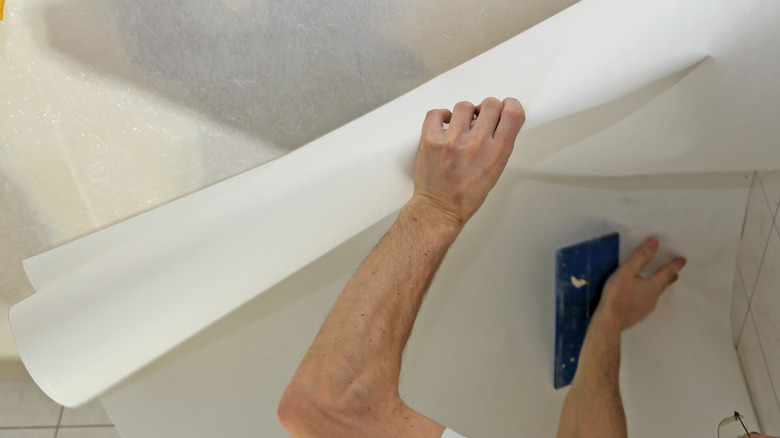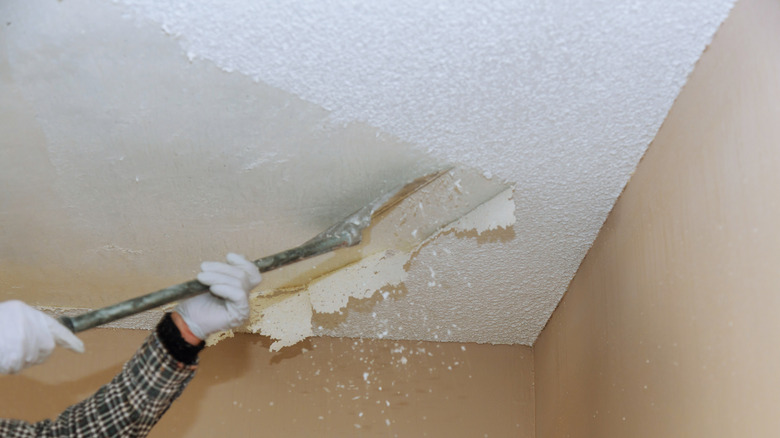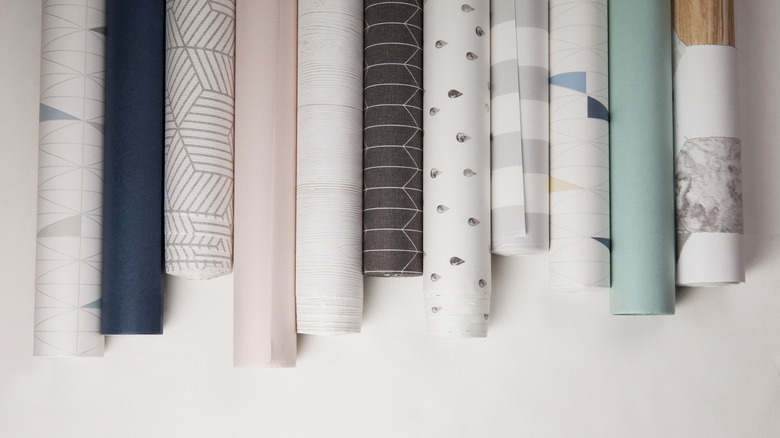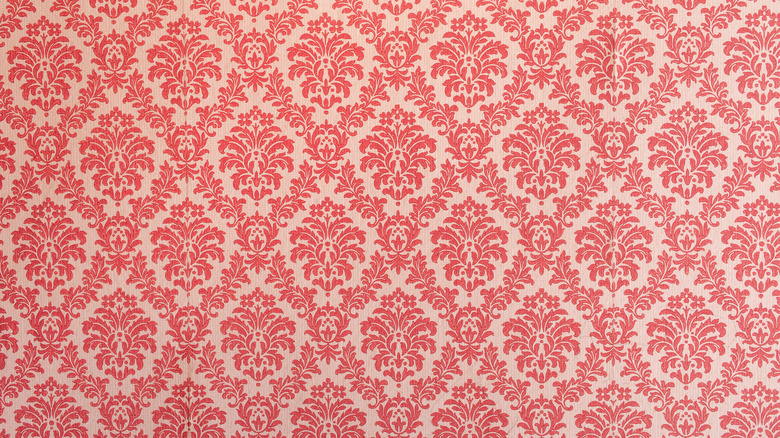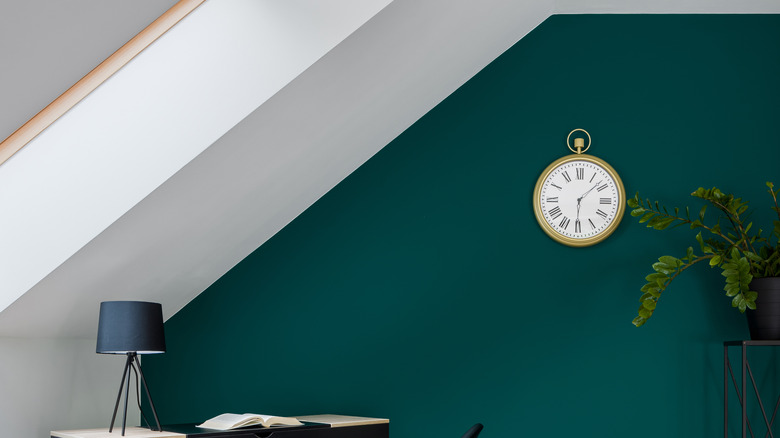5 Things To Know Before Adding Wallpaper To Your Ceiling
Every room needs something interesting, an unexpected element that makes it stand out. For years, accent walls have been the go-to for adding color or visual interest to a room, and a fresh coat of paint was also the primary technique for incorporating that pop of color. But recently, more people have been turning to wallpaper to add a fun accent to a room. For decades, wallpaper has been a rejected feature in home décor as it reminded too many people of their grandparent's bathrooms or a '70s living room.
But wallpaper is having a major moment in interior décor. With many options regarding colors and patterns, anyone can find an option matching their style. According to Arch Painting, this decorative element is also an inexpensive way to give a room a complete style makeover. But don't let the term wallpaper fool you; you're not required to keep this feature on the wall. Add wallpaper to the ceiling if you want a truly unexpected décor accent. Before you try this design feature, especially on your ceiling, you must know what you're getting yourself into.
1. You must have the right ceiling
For wallpaper to adhere correctly, it must have a smooth surface. Because of that, some ceilings might not be in a state where this decorative element will work. Any texture can show through the wallpaper, creating a wrinkly design or even leading to the material peeling. Popcorn ceilings are standard in many older homes. Surfaces like orange peel, knockdown ceilings, and swirl ceilings help to hide imperfections, says Rocket Homes. Unfortunately, these types of fifth walls aren't conducive to adding wallpaper. However, that doesn't mean you're out of luck. If your ceiling isn't smooth now, you can make it smoother. Popcorn ceilings can be scraped with little effort and time, revealing a smooth surface underneath.
In older homes, you have to be careful about the possibility of asbestos, according to Home Depot. Homes built before the mid-'80s should first use an EPA-approved test kit to collect samples for the presence of asbestos. If any is found, you may need an abatement team to get rid of the popcorn ceilings. It could be harder to remove if the popcorn ceilings are painted over, but a chemical stripper can extract the paint before scraping off the texture. Other ceiling textures can be removed with a drywall scraper, but in other cases, you may need to use plaster to create a smooth fifth wall.
2. Know the types of wallpaper
When choosing a wallpaper, you shouldn't only focus on colors and patterns. The type of wallpaper is just as important as what it looks like. Traditional wallpaper requires a paste; you'll have to apply it in strips. But newer options usually come as peel-and-stick panels similar to a large sticker. Both wallpapers will provide a stylish accent for your home, but it's the installation you'll have to consider. With prepasted wallpaper, you must soak it to activate the paste before applying it to the ceiling, says Samantha Santana.
Traditional wallpapers are best if you're looking for a long-term option, but the setting process can be technical and tricky. The variety that needs water to activate the glue isn't a good option for bathrooms or spaces where moisture might be high, as that can cause the wallpaper to peel unless a sealer is applied. Removable wallpapers have an adhesive on the back that doesn't need to be activated and can stick to the ceiling. This type of wallpaper isn't only removable but also repositionable, meaning if you accidentally put it in the wrong place, you can change the location. This makes it an excellent option for renters who can't permanently change their space. But peel-and-stick wallpapers often don't have as crisp a design as traditional varieties.
3. Prep work is important
Making sure your ceiling is in the best shape possible will ensure that the wallpaper stays on the fifth wall and doesn't have a lumpy or wrinkled appearance. You'll want to confirm that the surface is smooth, so seal holes or craters with spackle and even out bulges with sandpaper to create a clean surface, advises Milton & King. Then you'll want to clean the wall to remove any dust or debris from the sanding process.
Eggshell, satin and semi-gloss paints are the best to apply wallpaper; however, latex paints can tear the wallpaper if you ever remove it. You also don't want to use wallpaper directly to drywall because the paste can soak into the material and cause the wallpaper not to adhere. Give the wallpaper the best chance of sticking by applying a primer that will seal the ceiling. Within 24 hours of installing the wallpaper, you'll also want to wipe it down with a damp cloth to remove any last bit of dust or debris.
4. Think about color and pattern
This is the fun part of choosing wallpaper for your space. You'll be spoiled for choice now that wallpapers are seeing a resurgence in interior design. There are colors, patterns, and textures that will work for every room and indoor style. Wallpaper provides a fun opportunity for a pop of color, so consider using your ceiling as an unexpected accent that ties into the colors of the rest of your design.
Interior Designer Kathy Kuo from The Kuotes recommends using horizontal patterns to widen a room and vertical patterns to lengthen it. Large designs look best in larger rooms because it emphasizes the space. But small patterns in large areas can get lost or look too busy, so it's best to keep smaller patterns in small rooms. Damask and floral patterns are more romantic and traditional, but bold geometric options have a more contemporary look.
5. Consider the room's architecture
Wallpaper can be a powerful tool when it comes to interior design. In rooms that might not have a lot of wall space, wallpaper on the ceiling can add that extra pop of design the enclosure was missing. For instance, cabinets and appliances often take over kitchens, leaving only a small wall strip where you can add color or pattern. Or, if you have a room with many doors, windows, or built-in shelving, you can use wallpaper on the ceiling to make the space more visually attractive.
Wallpaper can also help accentuate rooms with slanted ceilings or dormers. These rooms can often be awkward to decorate, but adding wallpaper makes the home's architecture seem like a feature rather than an awkward construction. Underneath a sloped ceiling, you can place a bed or a sofa, says The Nordroom. Adding wallpaper to these sloped ceilings can give your furniture a backdrop that feels like an intentional design element.
